Analysis of Policies to Tackle Physical Inactivity in Public Health
VerifiedAdded on 2021/01/02
|19
|5284
|159
Report
AI Summary
This report analyzes the public health issue of physical inactivity, highlighting its prevalence and impact on global health. It identifies and examines policy documents from international, national, and local sources, including guidelines from the WHO, NICE, and UK government strategies. The report provides an in-depth analysis of policy initiatives designed to tackle physical inactivity, such as the ESCAPE-pain program and the Cycling and Walking Investment Strategy. Furthermore, it critiques relevant health promotion approaches within these initiatives, considering both medical and educational strategies for behavior change. The analysis includes an assessment of the government's role and interventions, along with data from the Active Lives Survey and Health Survey for England. The report concludes with a discussion of the effectiveness of various approaches and the importance of promoting active lifestyles through sustainable and efficient strategies.
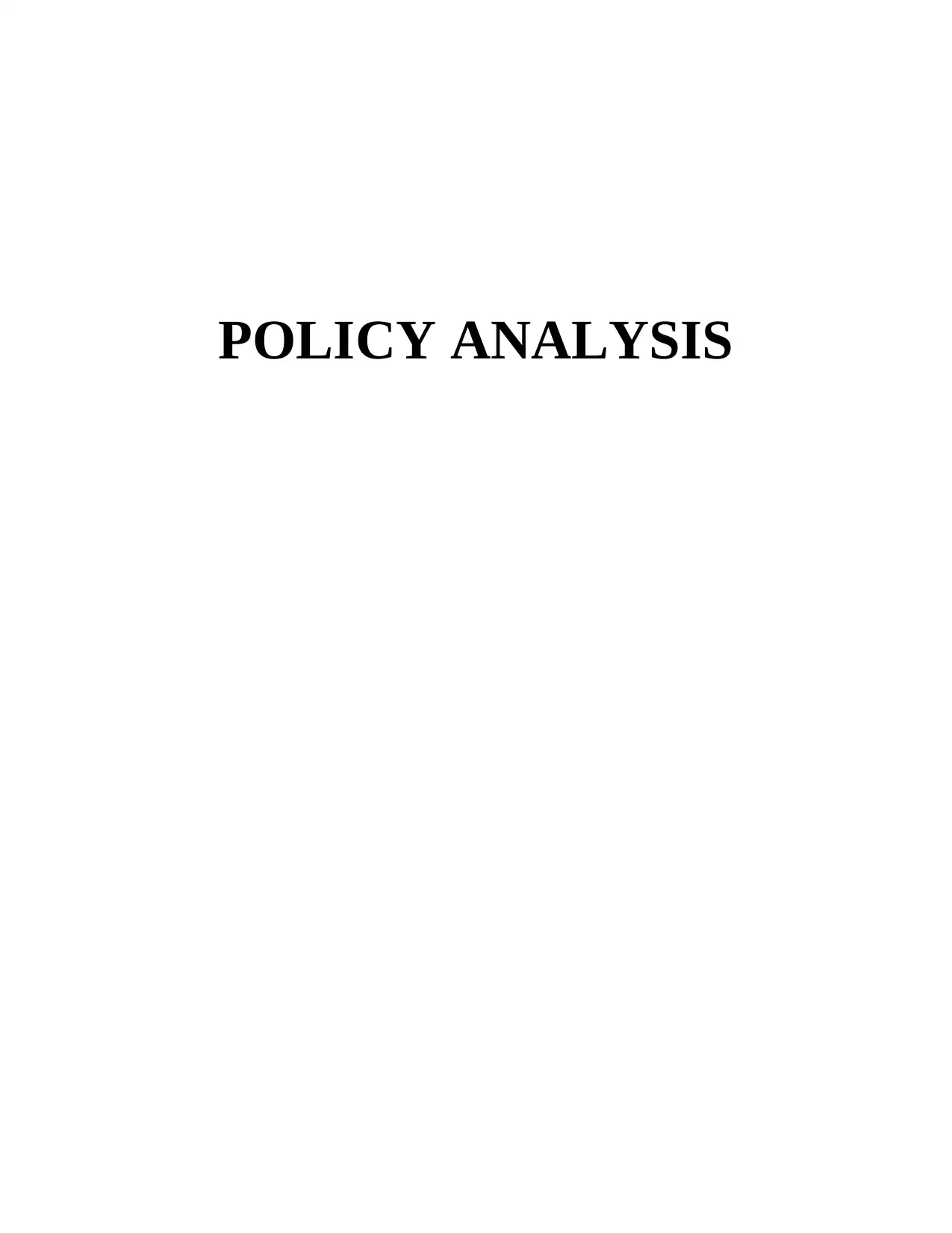
POLICY ANALYSIS
Paraphrase This Document
Need a fresh take? Get an instant paraphrase of this document with our AI Paraphraser
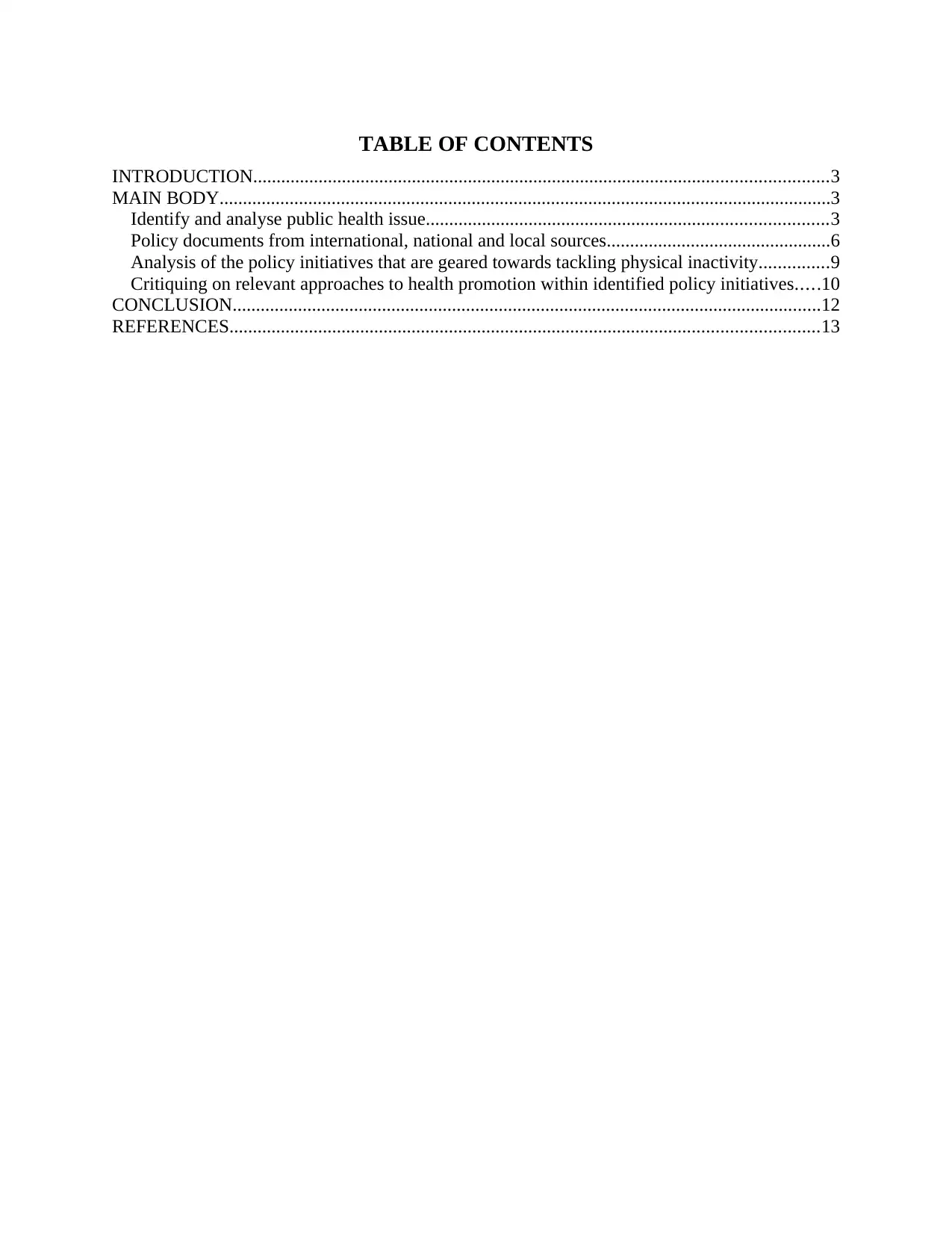
TABLE OF CONTENTS
INTRODUCTION...........................................................................................................................3
MAIN BODY...................................................................................................................................3
Identify and analyse public health issue......................................................................................3
Policy documents from international, national and local sources................................................6
Analysis of the policy initiatives that are geared towards tackling physical inactivity...............9
Critiquing on relevant approaches to health promotion within identified policy initiatives.....10
CONCLUSION..............................................................................................................................12
REFERENCES..............................................................................................................................13
INTRODUCTION...........................................................................................................................3
MAIN BODY...................................................................................................................................3
Identify and analyse public health issue......................................................................................3
Policy documents from international, national and local sources................................................6
Analysis of the policy initiatives that are geared towards tackling physical inactivity...............9
Critiquing on relevant approaches to health promotion within identified policy initiatives.....10
CONCLUSION..............................................................................................................................12
REFERENCES..............................................................................................................................13
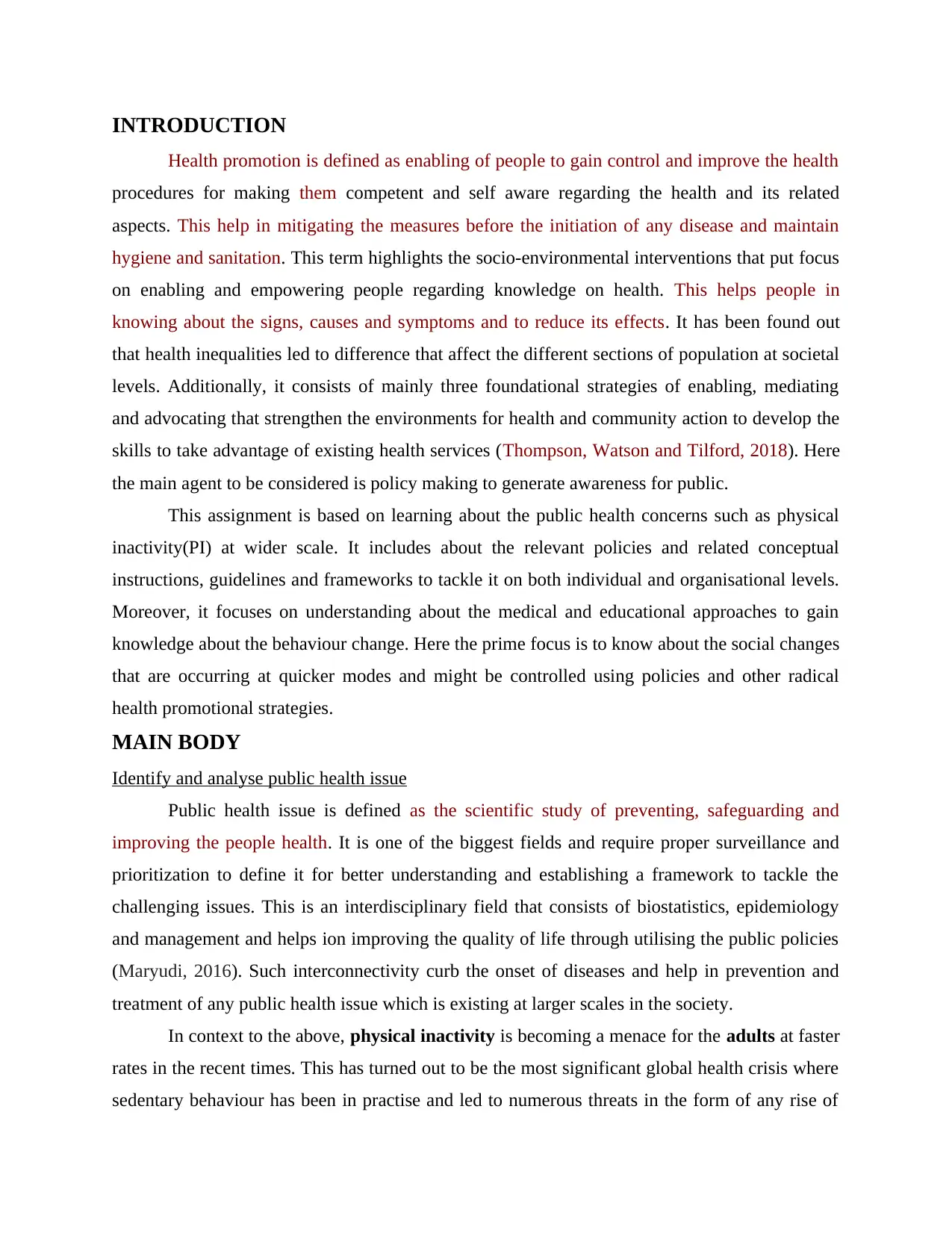
INTRODUCTION
Health promotion is defined as enabling of people to gain control and improve the health
procedures for making them competent and self aware regarding the health and its related
aspects. This help in mitigating the measures before the initiation of any disease and maintain
hygiene and sanitation. This term highlights the socio-environmental interventions that put focus
on enabling and empowering people regarding knowledge on health. This helps people in
knowing about the signs, causes and symptoms and to reduce its effects. It has been found out
that health inequalities led to difference that affect the different sections of population at societal
levels. Additionally, it consists of mainly three foundational strategies of enabling, mediating
and advocating that strengthen the environments for health and community action to develop the
skills to take advantage of existing health services (Thompson, Watson and Tilford, 2018). Here
the main agent to be considered is policy making to generate awareness for public.
This assignment is based on learning about the public health concerns such as physical
inactivity(PI) at wider scale. It includes about the relevant policies and related conceptual
instructions, guidelines and frameworks to tackle it on both individual and organisational levels.
Moreover, it focuses on understanding about the medical and educational approaches to gain
knowledge about the behaviour change. Here the prime focus is to know about the social changes
that are occurring at quicker modes and might be controlled using policies and other radical
health promotional strategies.
MAIN BODY
Identify and analyse public health issue
Public health issue is defined as the scientific study of preventing, safeguarding and
improving the people health. It is one of the biggest fields and require proper surveillance and
prioritization to define it for better understanding and establishing a framework to tackle the
challenging issues. This is an interdisciplinary field that consists of biostatistics, epidemiology
and management and helps ion improving the quality of life through utilising the public policies
(Maryudi, 2016). Such interconnectivity curb the onset of diseases and help in prevention and
treatment of any public health issue which is existing at larger scales in the society.
In context to the above, physical inactivity is becoming a menace for the adults at faster
rates in the recent times. This has turned out to be the most significant global health crisis where
sedentary behaviour has been in practise and led to numerous threats in the form of any rise of
Health promotion is defined as enabling of people to gain control and improve the health
procedures for making them competent and self aware regarding the health and its related
aspects. This help in mitigating the measures before the initiation of any disease and maintain
hygiene and sanitation. This term highlights the socio-environmental interventions that put focus
on enabling and empowering people regarding knowledge on health. This helps people in
knowing about the signs, causes and symptoms and to reduce its effects. It has been found out
that health inequalities led to difference that affect the different sections of population at societal
levels. Additionally, it consists of mainly three foundational strategies of enabling, mediating
and advocating that strengthen the environments for health and community action to develop the
skills to take advantage of existing health services (Thompson, Watson and Tilford, 2018). Here
the main agent to be considered is policy making to generate awareness for public.
This assignment is based on learning about the public health concerns such as physical
inactivity(PI) at wider scale. It includes about the relevant policies and related conceptual
instructions, guidelines and frameworks to tackle it on both individual and organisational levels.
Moreover, it focuses on understanding about the medical and educational approaches to gain
knowledge about the behaviour change. Here the prime focus is to know about the social changes
that are occurring at quicker modes and might be controlled using policies and other radical
health promotional strategies.
MAIN BODY
Identify and analyse public health issue
Public health issue is defined as the scientific study of preventing, safeguarding and
improving the people health. It is one of the biggest fields and require proper surveillance and
prioritization to define it for better understanding and establishing a framework to tackle the
challenging issues. This is an interdisciplinary field that consists of biostatistics, epidemiology
and management and helps ion improving the quality of life through utilising the public policies
(Maryudi, 2016). Such interconnectivity curb the onset of diseases and help in prevention and
treatment of any public health issue which is existing at larger scales in the society.
In context to the above, physical inactivity is becoming a menace for the adults at faster
rates in the recent times. This has turned out to be the most significant global health crisis where
sedentary behaviour has been in practise and led to numerous threats in the form of any rise of
⊘ This is a preview!⊘
Do you want full access?
Subscribe today to unlock all pages.

Trusted by 1+ million students worldwide
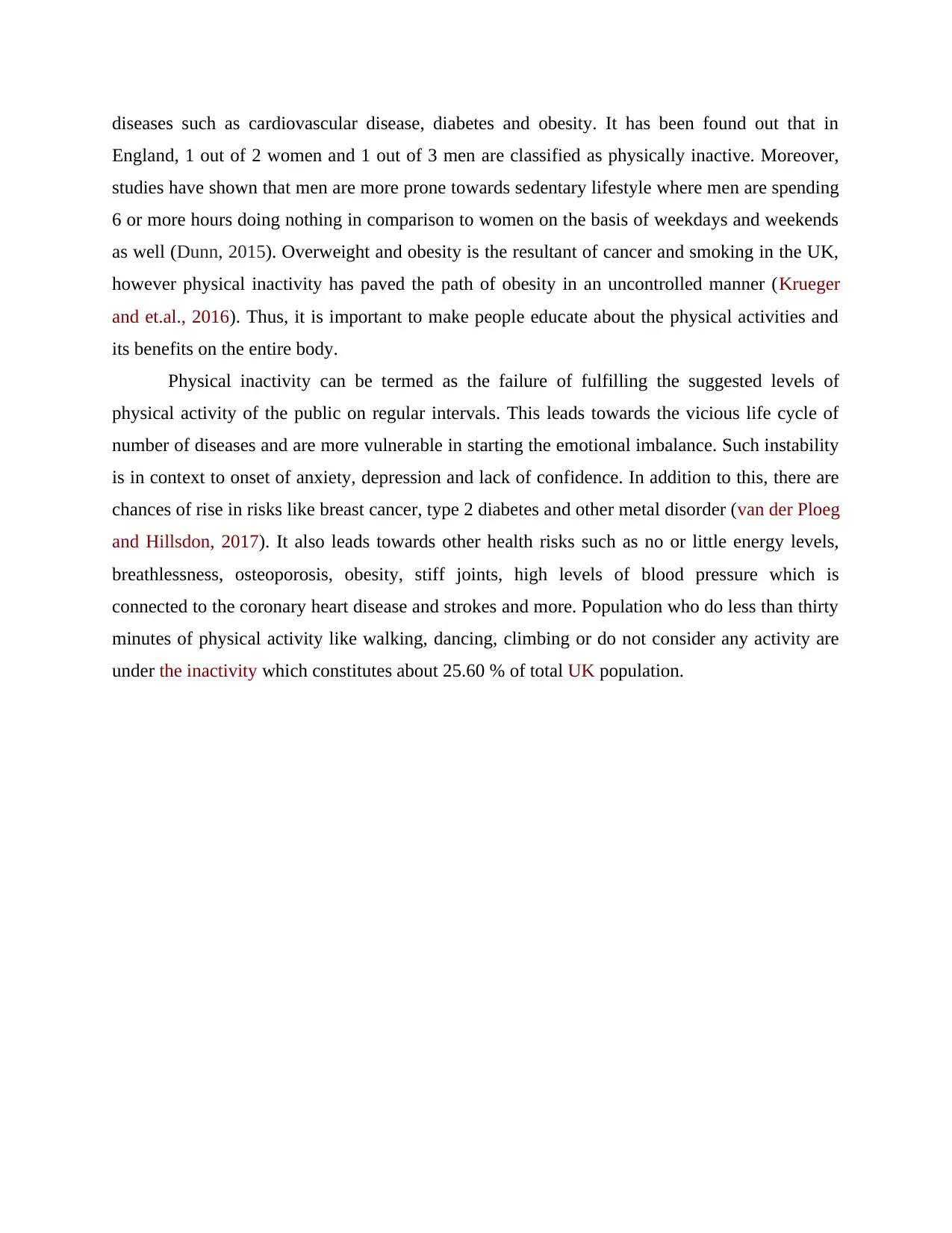
diseases such as cardiovascular disease, diabetes and obesity. It has been found out that in
England, 1 out of 2 women and 1 out of 3 men are classified as physically inactive. Moreover,
studies have shown that men are more prone towards sedentary lifestyle where men are spending
6 or more hours doing nothing in comparison to women on the basis of weekdays and weekends
as well (Dunn, 2015). Overweight and obesity is the resultant of cancer and smoking in the UK,
however physical inactivity has paved the path of obesity in an uncontrolled manner (Krueger
and et.al., 2016). Thus, it is important to make people educate about the physical activities and
its benefits on the entire body.
Physical inactivity can be termed as the failure of fulfilling the suggested levels of
physical activity of the public on regular intervals. This leads towards the vicious life cycle of
number of diseases and are more vulnerable in starting the emotional imbalance. Such instability
is in context to onset of anxiety, depression and lack of confidence. In addition to this, there are
chances of rise in risks like breast cancer, type 2 diabetes and other metal disorder (van der Ploeg
and Hillsdon, 2017). It also leads towards other health risks such as no or little energy levels,
breathlessness, osteoporosis, obesity, stiff joints, high levels of blood pressure which is
connected to the coronary heart disease and strokes and more. Population who do less than thirty
minutes of physical activity like walking, dancing, climbing or do not consider any activity are
under the inactivity which constitutes about 25.60 % of total UK population.
England, 1 out of 2 women and 1 out of 3 men are classified as physically inactive. Moreover,
studies have shown that men are more prone towards sedentary lifestyle where men are spending
6 or more hours doing nothing in comparison to women on the basis of weekdays and weekends
as well (Dunn, 2015). Overweight and obesity is the resultant of cancer and smoking in the UK,
however physical inactivity has paved the path of obesity in an uncontrolled manner (Krueger
and et.al., 2016). Thus, it is important to make people educate about the physical activities and
its benefits on the entire body.
Physical inactivity can be termed as the failure of fulfilling the suggested levels of
physical activity of the public on regular intervals. This leads towards the vicious life cycle of
number of diseases and are more vulnerable in starting the emotional imbalance. Such instability
is in context to onset of anxiety, depression and lack of confidence. In addition to this, there are
chances of rise in risks like breast cancer, type 2 diabetes and other metal disorder (van der Ploeg
and Hillsdon, 2017). It also leads towards other health risks such as no or little energy levels,
breathlessness, osteoporosis, obesity, stiff joints, high levels of blood pressure which is
connected to the coronary heart disease and strokes and more. Population who do less than thirty
minutes of physical activity like walking, dancing, climbing or do not consider any activity are
under the inactivity which constitutes about 25.60 % of total UK population.
Paraphrase This Document
Need a fresh take? Get an instant paraphrase of this document with our AI Paraphraser
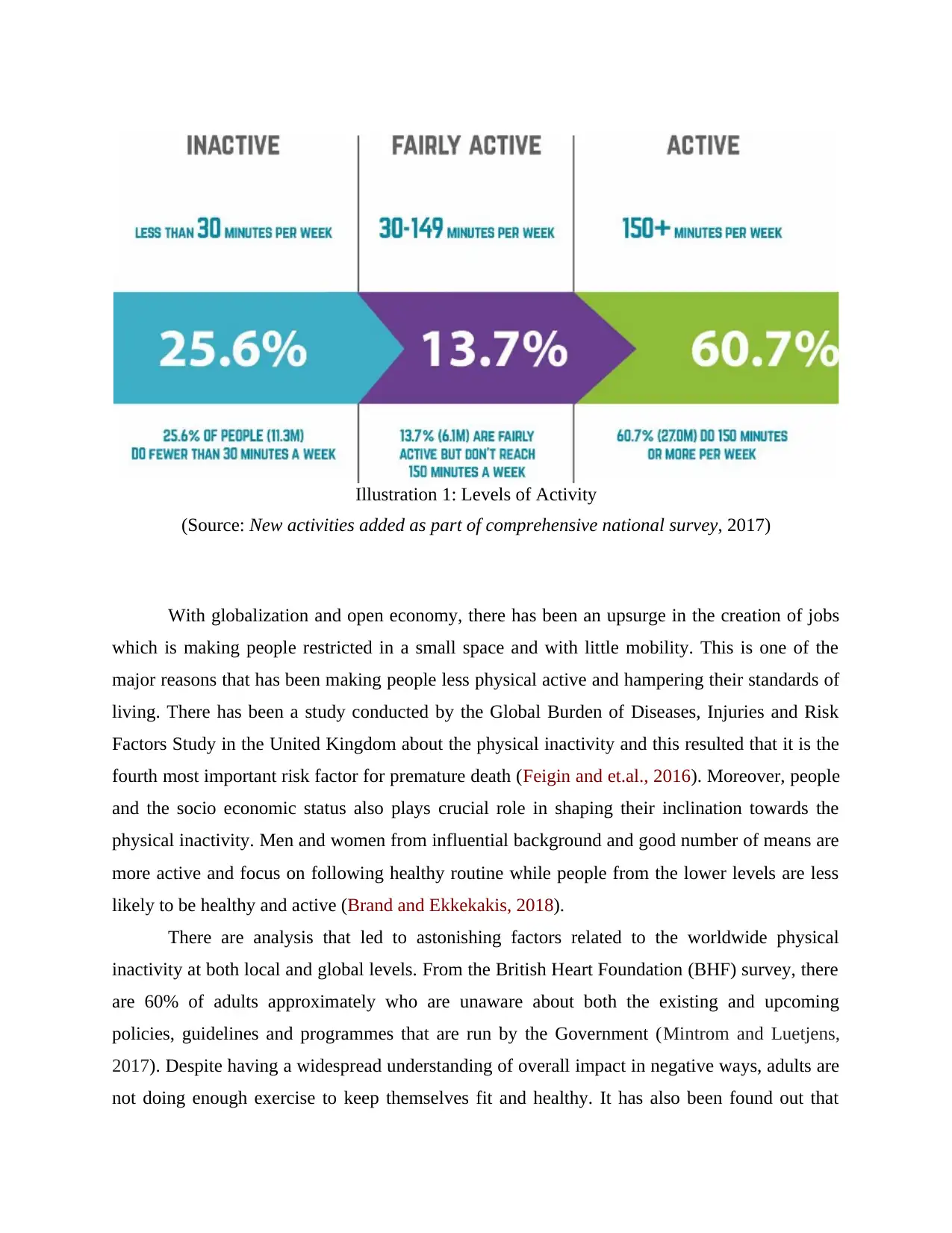
With globalization and open economy, there has been an upsurge in the creation of jobs
which is making people restricted in a small space and with little mobility. This is one of the
major reasons that has been making people less physical active and hampering their standards of
living. There has been a study conducted by the Global Burden of Diseases, Injuries and Risk
Factors Study in the United Kingdom about the physical inactivity and this resulted that it is the
fourth most important risk factor for premature death (Feigin and et.al., 2016). Moreover, people
and the socio economic status also plays crucial role in shaping their inclination towards the
physical inactivity. Men and women from influential background and good number of means are
more active and focus on following healthy routine while people from the lower levels are less
likely to be healthy and active (Brand and Ekkekakis, 2018).
There are analysis that led to astonishing factors related to the worldwide physical
inactivity at both local and global levels. From the British Heart Foundation (BHF) survey, there
are 60% of adults approximately who are unaware about both the existing and upcoming
policies, guidelines and programmes that are run by the Government (Mintrom and Luetjens,
2017). Despite having a widespread understanding of overall impact in negative ways, adults are
not doing enough exercise to keep themselves fit and healthy. It has also been found out that
Illustration 1: Levels of Activity
(Source: New activities added as part of comprehensive national survey, 2017)
which is making people restricted in a small space and with little mobility. This is one of the
major reasons that has been making people less physical active and hampering their standards of
living. There has been a study conducted by the Global Burden of Diseases, Injuries and Risk
Factors Study in the United Kingdom about the physical inactivity and this resulted that it is the
fourth most important risk factor for premature death (Feigin and et.al., 2016). Moreover, people
and the socio economic status also plays crucial role in shaping their inclination towards the
physical inactivity. Men and women from influential background and good number of means are
more active and focus on following healthy routine while people from the lower levels are less
likely to be healthy and active (Brand and Ekkekakis, 2018).
There are analysis that led to astonishing factors related to the worldwide physical
inactivity at both local and global levels. From the British Heart Foundation (BHF) survey, there
are 60% of adults approximately who are unaware about both the existing and upcoming
policies, guidelines and programmes that are run by the Government (Mintrom and Luetjens,
2017). Despite having a widespread understanding of overall impact in negative ways, adults are
not doing enough exercise to keep themselves fit and healthy. It has also been found out that
Illustration 1: Levels of Activity
(Source: New activities added as part of comprehensive national survey, 2017)
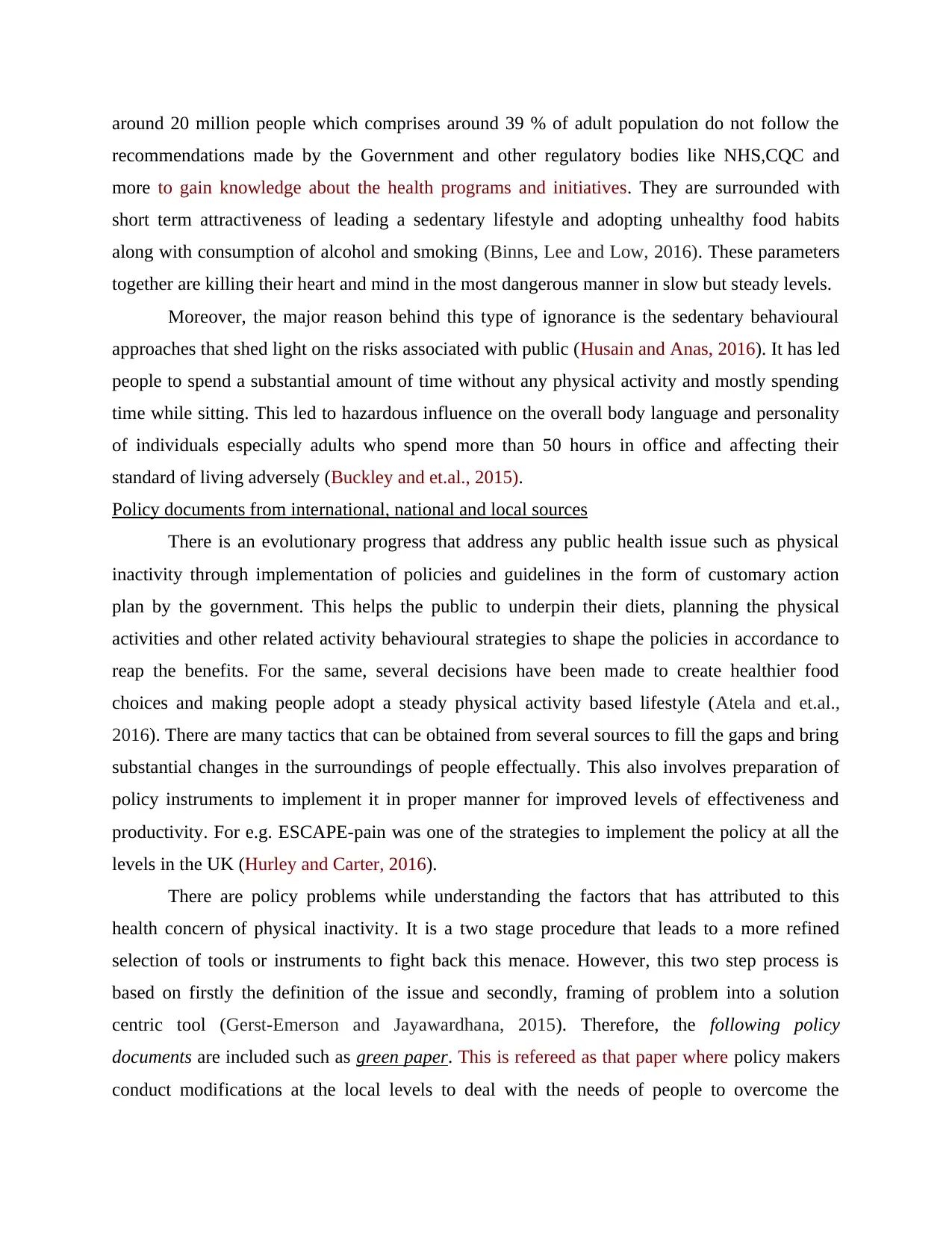
around 20 million people which comprises around 39 % of adult population do not follow the
recommendations made by the Government and other regulatory bodies like NHS,CQC and
more to gain knowledge about the health programs and initiatives. They are surrounded with
short term attractiveness of leading a sedentary lifestyle and adopting unhealthy food habits
along with consumption of alcohol and smoking (Binns, Lee and Low, 2016). These parameters
together are killing their heart and mind in the most dangerous manner in slow but steady levels.
Moreover, the major reason behind this type of ignorance is the sedentary behavioural
approaches that shed light on the risks associated with public (Husain and Anas, 2016). It has led
people to spend a substantial amount of time without any physical activity and mostly spending
time while sitting. This led to hazardous influence on the overall body language and personality
of individuals especially adults who spend more than 50 hours in office and affecting their
standard of living adversely (Buckley and et.al., 2015).
Policy documents from international, national and local sources
There is an evolutionary progress that address any public health issue such as physical
inactivity through implementation of policies and guidelines in the form of customary action
plan by the government. This helps the public to underpin their diets, planning the physical
activities and other related activity behavioural strategies to shape the policies in accordance to
reap the benefits. For the same, several decisions have been made to create healthier food
choices and making people adopt a steady physical activity based lifestyle (Atela and et.al.,
2016). There are many tactics that can be obtained from several sources to fill the gaps and bring
substantial changes in the surroundings of people effectually. This also involves preparation of
policy instruments to implement it in proper manner for improved levels of effectiveness and
productivity. For e.g. ESCAPE-pain was one of the strategies to implement the policy at all the
levels in the UK (Hurley and Carter, 2016).
There are policy problems while understanding the factors that has attributed to this
health concern of physical inactivity. It is a two stage procedure that leads to a more refined
selection of tools or instruments to fight back this menace. However, this two step process is
based on firstly the definition of the issue and secondly, framing of problem into a solution
centric tool (Gerst-Emerson and Jayawardhana, 2015). Therefore, the following policy
documents are included such as green paper. This is refereed as that paper where policy makers
conduct modifications at the local levels to deal with the needs of people to overcome the
recommendations made by the Government and other regulatory bodies like NHS,CQC and
more to gain knowledge about the health programs and initiatives. They are surrounded with
short term attractiveness of leading a sedentary lifestyle and adopting unhealthy food habits
along with consumption of alcohol and smoking (Binns, Lee and Low, 2016). These parameters
together are killing their heart and mind in the most dangerous manner in slow but steady levels.
Moreover, the major reason behind this type of ignorance is the sedentary behavioural
approaches that shed light on the risks associated with public (Husain and Anas, 2016). It has led
people to spend a substantial amount of time without any physical activity and mostly spending
time while sitting. This led to hazardous influence on the overall body language and personality
of individuals especially adults who spend more than 50 hours in office and affecting their
standard of living adversely (Buckley and et.al., 2015).
Policy documents from international, national and local sources
There is an evolutionary progress that address any public health issue such as physical
inactivity through implementation of policies and guidelines in the form of customary action
plan by the government. This helps the public to underpin their diets, planning the physical
activities and other related activity behavioural strategies to shape the policies in accordance to
reap the benefits. For the same, several decisions have been made to create healthier food
choices and making people adopt a steady physical activity based lifestyle (Atela and et.al.,
2016). There are many tactics that can be obtained from several sources to fill the gaps and bring
substantial changes in the surroundings of people effectually. This also involves preparation of
policy instruments to implement it in proper manner for improved levels of effectiveness and
productivity. For e.g. ESCAPE-pain was one of the strategies to implement the policy at all the
levels in the UK (Hurley and Carter, 2016).
There are policy problems while understanding the factors that has attributed to this
health concern of physical inactivity. It is a two stage procedure that leads to a more refined
selection of tools or instruments to fight back this menace. However, this two step process is
based on firstly the definition of the issue and secondly, framing of problem into a solution
centric tool (Gerst-Emerson and Jayawardhana, 2015). Therefore, the following policy
documents are included such as green paper. This is refereed as that paper where policy makers
conduct modifications at the local levels to deal with the needs of people to overcome the
⊘ This is a preview!⊘
Do you want full access?
Subscribe today to unlock all pages.

Trusted by 1+ million students worldwide
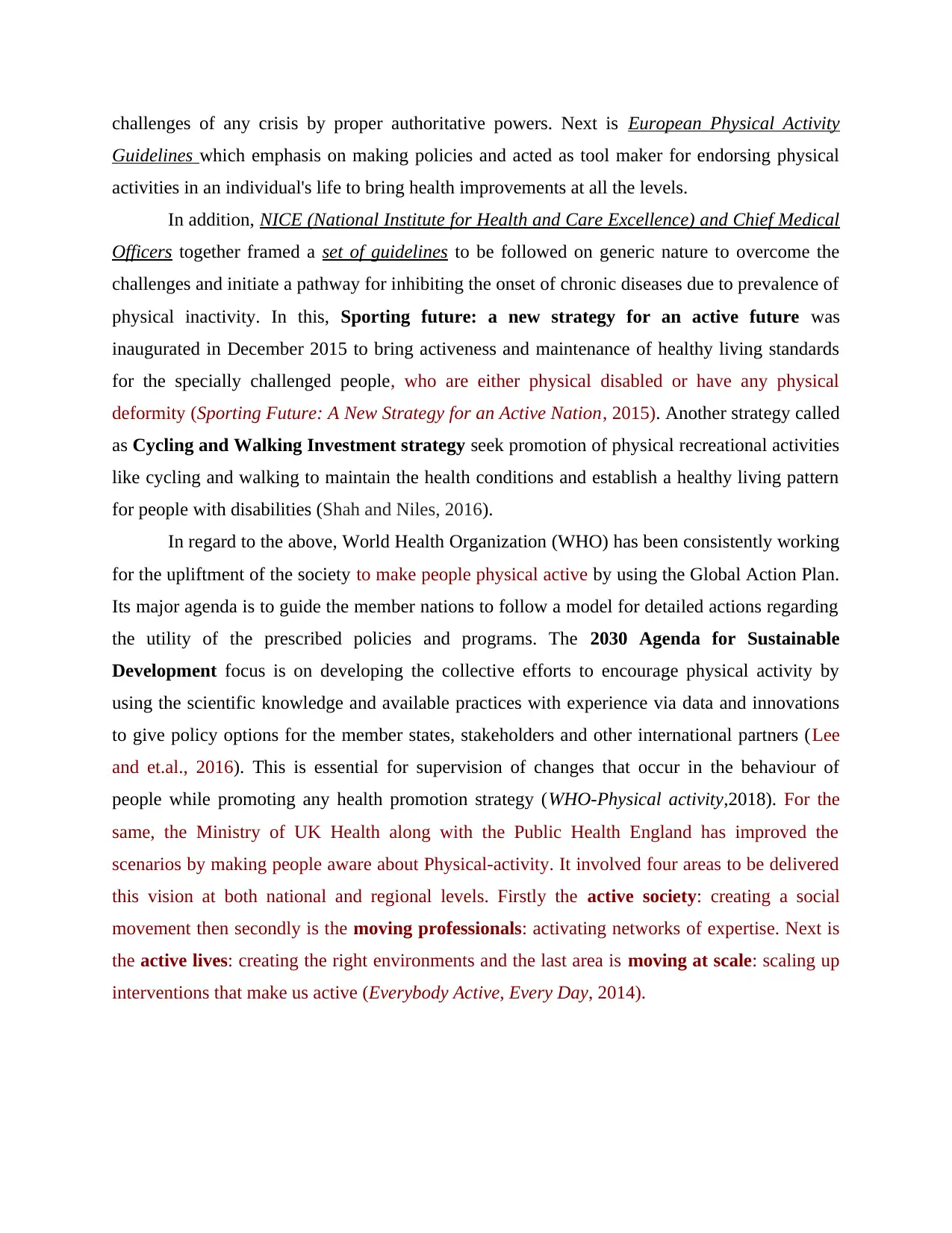
challenges of any crisis by proper authoritative powers. Next is European Physical Activity
Guidelines which emphasis on making policies and acted as tool maker for endorsing physical
activities in an individual's life to bring health improvements at all the levels.
In addition, NICE (National Institute for Health and Care Excellence) and Chief Medical
Officers together framed a set of guidelines to be followed on generic nature to overcome the
challenges and initiate a pathway for inhibiting the onset of chronic diseases due to prevalence of
physical inactivity. In this, Sporting future: a new strategy for an active future was
inaugurated in December 2015 to bring activeness and maintenance of healthy living standards
for the specially challenged people, who are either physical disabled or have any physical
deformity (Sporting Future: A New Strategy for an Active Nation, 2015). Another strategy called
as Cycling and Walking Investment strategy seek promotion of physical recreational activities
like cycling and walking to maintain the health conditions and establish a healthy living pattern
for people with disabilities (Shah and Niles, 2016).
In regard to the above, World Health Organization (WHO) has been consistently working
for the upliftment of the society to make people physical active by using the Global Action Plan.
Its major agenda is to guide the member nations to follow a model for detailed actions regarding
the utility of the prescribed policies and programs. The 2030 Agenda for Sustainable
Development focus is on developing the collective efforts to encourage physical activity by
using the scientific knowledge and available practices with experience via data and innovations
to give policy options for the member states, stakeholders and other international partners (Lee
and et.al., 2016). This is essential for supervision of changes that occur in the behaviour of
people while promoting any health promotion strategy (WHO-Physical activity,2018). For the
same, the Ministry of UK Health along with the Public Health England has improved the
scenarios by making people aware about Physical-activity. It involved four areas to be delivered
this vision at both national and regional levels. Firstly the active society: creating a social
movement then secondly is the moving professionals: activating networks of expertise. Next is
the active lives: creating the right environments and the last area is moving at scale: scaling up
interventions that make us active (Everybody Active, Every Day, 2014).
Guidelines which emphasis on making policies and acted as tool maker for endorsing physical
activities in an individual's life to bring health improvements at all the levels.
In addition, NICE (National Institute for Health and Care Excellence) and Chief Medical
Officers together framed a set of guidelines to be followed on generic nature to overcome the
challenges and initiate a pathway for inhibiting the onset of chronic diseases due to prevalence of
physical inactivity. In this, Sporting future: a new strategy for an active future was
inaugurated in December 2015 to bring activeness and maintenance of healthy living standards
for the specially challenged people, who are either physical disabled or have any physical
deformity (Sporting Future: A New Strategy for an Active Nation, 2015). Another strategy called
as Cycling and Walking Investment strategy seek promotion of physical recreational activities
like cycling and walking to maintain the health conditions and establish a healthy living pattern
for people with disabilities (Shah and Niles, 2016).
In regard to the above, World Health Organization (WHO) has been consistently working
for the upliftment of the society to make people physical active by using the Global Action Plan.
Its major agenda is to guide the member nations to follow a model for detailed actions regarding
the utility of the prescribed policies and programs. The 2030 Agenda for Sustainable
Development focus is on developing the collective efforts to encourage physical activity by
using the scientific knowledge and available practices with experience via data and innovations
to give policy options for the member states, stakeholders and other international partners (Lee
and et.al., 2016). This is essential for supervision of changes that occur in the behaviour of
people while promoting any health promotion strategy (WHO-Physical activity,2018). For the
same, the Ministry of UK Health along with the Public Health England has improved the
scenarios by making people aware about Physical-activity. It involved four areas to be delivered
this vision at both national and regional levels. Firstly the active society: creating a social
movement then secondly is the moving professionals: activating networks of expertise. Next is
the active lives: creating the right environments and the last area is moving at scale: scaling up
interventions that make us active (Everybody Active, Every Day, 2014).
Paraphrase This Document
Need a fresh take? Get an instant paraphrase of this document with our AI Paraphraser
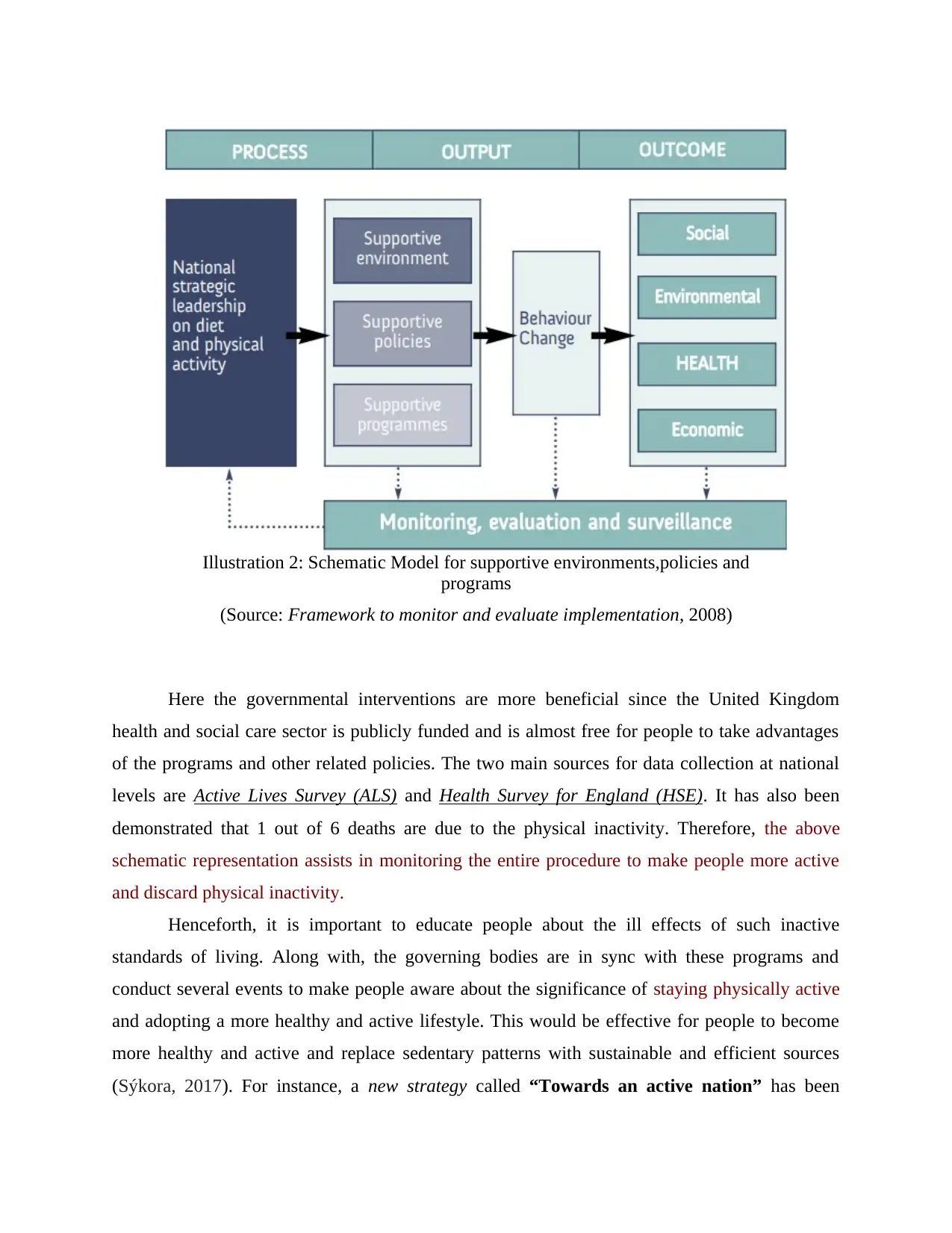
Here the governmental interventions are more beneficial since the United Kingdom
health and social care sector is publicly funded and is almost free for people to take advantages
of the programs and other related policies. The two main sources for data collection at national
levels are Active Lives Survey (ALS) and Health Survey for England (HSE). It has also been
demonstrated that 1 out of 6 deaths are due to the physical inactivity. Therefore, the above
schematic representation assists in monitoring the entire procedure to make people more active
and discard physical inactivity.
Henceforth, it is important to educate people about the ill effects of such inactive
standards of living. Along with, the governing bodies are in sync with these programs and
conduct several events to make people aware about the significance of staying physically active
and adopting a more healthy and active lifestyle. This would be effective for people to become
more healthy and active and replace sedentary patterns with sustainable and efficient sources
(Sýkora, 2017). For instance, a new strategy called “Towards an active nation” has been
Illustration 2: Schematic Model for supportive environments,policies and
programs
(Source: Framework to monitor and evaluate implementation, 2008)
health and social care sector is publicly funded and is almost free for people to take advantages
of the programs and other related policies. The two main sources for data collection at national
levels are Active Lives Survey (ALS) and Health Survey for England (HSE). It has also been
demonstrated that 1 out of 6 deaths are due to the physical inactivity. Therefore, the above
schematic representation assists in monitoring the entire procedure to make people more active
and discard physical inactivity.
Henceforth, it is important to educate people about the ill effects of such inactive
standards of living. Along with, the governing bodies are in sync with these programs and
conduct several events to make people aware about the significance of staying physically active
and adopting a more healthy and active lifestyle. This would be effective for people to become
more healthy and active and replace sedentary patterns with sustainable and efficient sources
(Sýkora, 2017). For instance, a new strategy called “Towards an active nation” has been
Illustration 2: Schematic Model for supportive environments,policies and
programs
(Source: Framework to monitor and evaluate implementation, 2008)
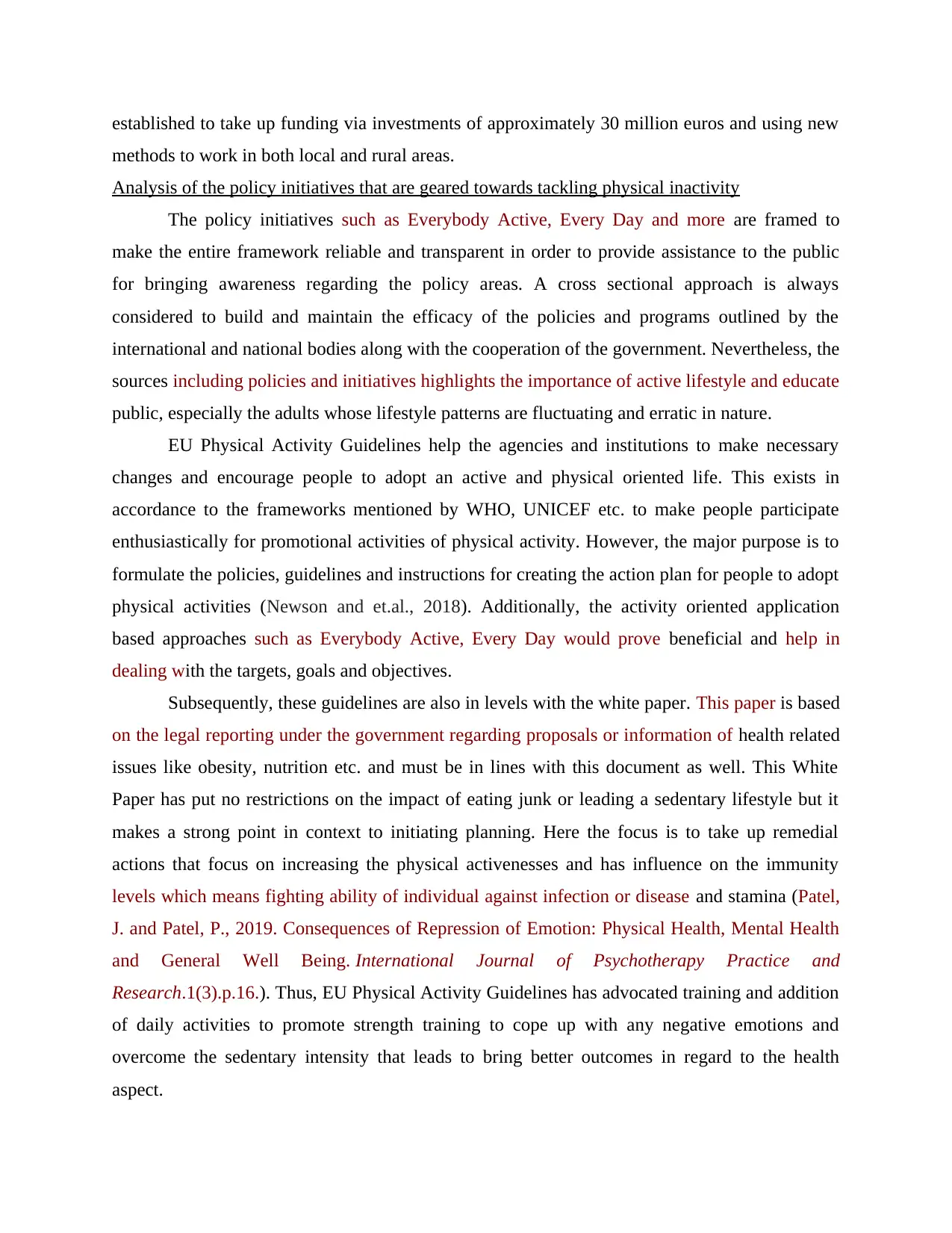
established to take up funding via investments of approximately 30 million euros and using new
methods to work in both local and rural areas.
Analysis of the policy initiatives that are geared towards tackling physical inactivity
The policy initiatives such as Everybody Active, Every Day and more are framed to
make the entire framework reliable and transparent in order to provide assistance to the public
for bringing awareness regarding the policy areas. A cross sectional approach is always
considered to build and maintain the efficacy of the policies and programs outlined by the
international and national bodies along with the cooperation of the government. Nevertheless, the
sources including policies and initiatives highlights the importance of active lifestyle and educate
public, especially the adults whose lifestyle patterns are fluctuating and erratic in nature.
EU Physical Activity Guidelines help the agencies and institutions to make necessary
changes and encourage people to adopt an active and physical oriented life. This exists in
accordance to the frameworks mentioned by WHO, UNICEF etc. to make people participate
enthusiastically for promotional activities of physical activity. However, the major purpose is to
formulate the policies, guidelines and instructions for creating the action plan for people to adopt
physical activities (Newson and et.al., 2018). Additionally, the activity oriented application
based approaches such as Everybody Active, Every Day would prove beneficial and help in
dealing with the targets, goals and objectives.
Subsequently, these guidelines are also in levels with the white paper. This paper is based
on the legal reporting under the government regarding proposals or information of health related
issues like obesity, nutrition etc. and must be in lines with this document as well. This White
Paper has put no restrictions on the impact of eating junk or leading a sedentary lifestyle but it
makes a strong point in context to initiating planning. Here the focus is to take up remedial
actions that focus on increasing the physical activenesses and has influence on the immunity
levels which means fighting ability of individual against infection or disease and stamina (Patel,
J. and Patel, P., 2019. Consequences of Repression of Emotion: Physical Health, Mental Health
and General Well Being. International Journal of Psychotherapy Practice and
Research.1(3).p.16.). Thus, EU Physical Activity Guidelines has advocated training and addition
of daily activities to promote strength training to cope up with any negative emotions and
overcome the sedentary intensity that leads to bring better outcomes in regard to the health
aspect.
methods to work in both local and rural areas.
Analysis of the policy initiatives that are geared towards tackling physical inactivity
The policy initiatives such as Everybody Active, Every Day and more are framed to
make the entire framework reliable and transparent in order to provide assistance to the public
for bringing awareness regarding the policy areas. A cross sectional approach is always
considered to build and maintain the efficacy of the policies and programs outlined by the
international and national bodies along with the cooperation of the government. Nevertheless, the
sources including policies and initiatives highlights the importance of active lifestyle and educate
public, especially the adults whose lifestyle patterns are fluctuating and erratic in nature.
EU Physical Activity Guidelines help the agencies and institutions to make necessary
changes and encourage people to adopt an active and physical oriented life. This exists in
accordance to the frameworks mentioned by WHO, UNICEF etc. to make people participate
enthusiastically for promotional activities of physical activity. However, the major purpose is to
formulate the policies, guidelines and instructions for creating the action plan for people to adopt
physical activities (Newson and et.al., 2018). Additionally, the activity oriented application
based approaches such as Everybody Active, Every Day would prove beneficial and help in
dealing with the targets, goals and objectives.
Subsequently, these guidelines are also in levels with the white paper. This paper is based
on the legal reporting under the government regarding proposals or information of health related
issues like obesity, nutrition etc. and must be in lines with this document as well. This White
Paper has put no restrictions on the impact of eating junk or leading a sedentary lifestyle but it
makes a strong point in context to initiating planning. Here the focus is to take up remedial
actions that focus on increasing the physical activenesses and has influence on the immunity
levels which means fighting ability of individual against infection or disease and stamina (Patel,
J. and Patel, P., 2019. Consequences of Repression of Emotion: Physical Health, Mental Health
and General Well Being. International Journal of Psychotherapy Practice and
Research.1(3).p.16.). Thus, EU Physical Activity Guidelines has advocated training and addition
of daily activities to promote strength training to cope up with any negative emotions and
overcome the sedentary intensity that leads to bring better outcomes in regard to the health
aspect.
⊘ This is a preview!⊘
Do you want full access?
Subscribe today to unlock all pages.

Trusted by 1+ million students worldwide
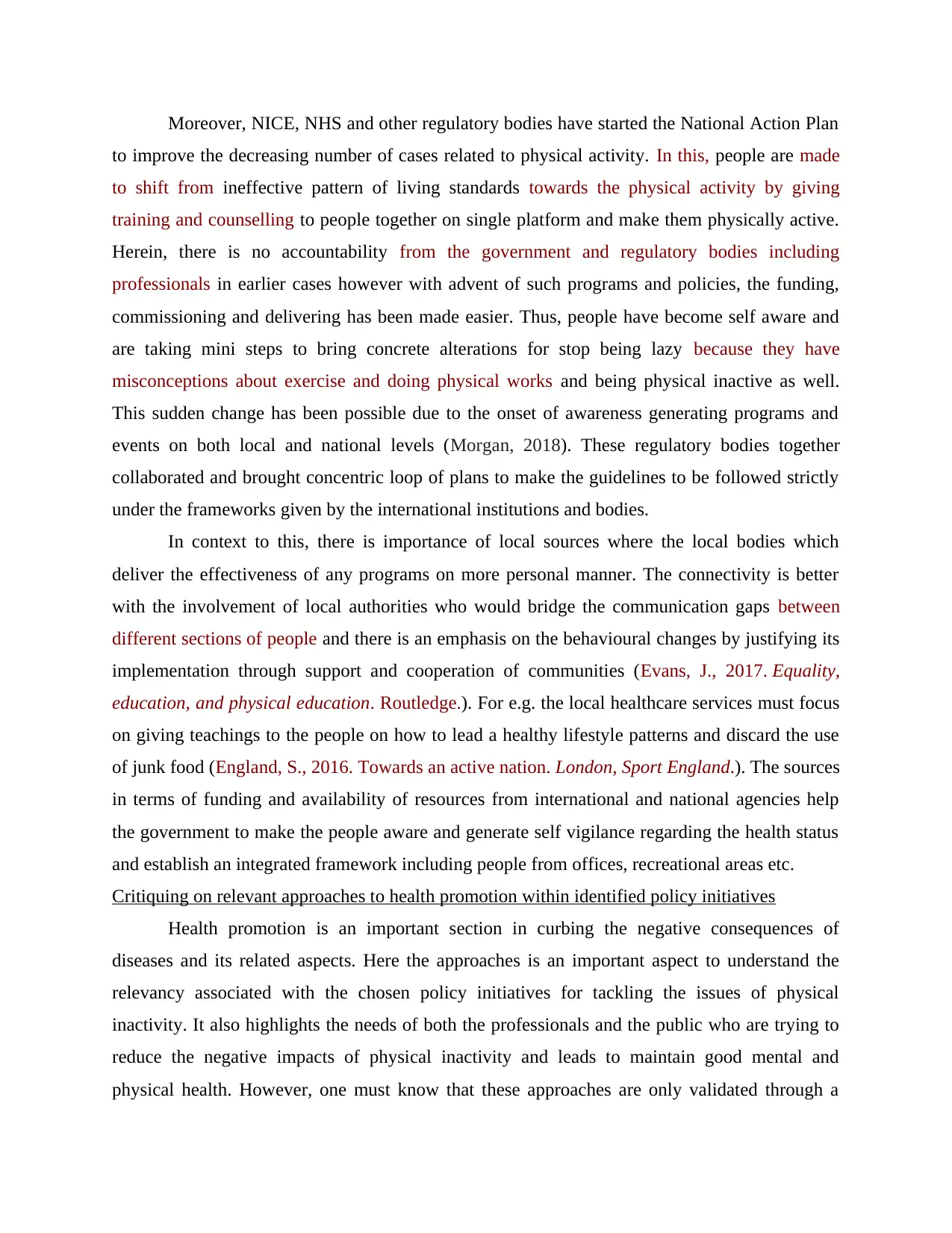
Moreover, NICE, NHS and other regulatory bodies have started the National Action Plan
to improve the decreasing number of cases related to physical activity. In this, people are made
to shift from ineffective pattern of living standards towards the physical activity by giving
training and counselling to people together on single platform and make them physically active.
Herein, there is no accountability from the government and regulatory bodies including
professionals in earlier cases however with advent of such programs and policies, the funding,
commissioning and delivering has been made easier. Thus, people have become self aware and
are taking mini steps to bring concrete alterations for stop being lazy because they have
misconceptions about exercise and doing physical works and being physical inactive as well.
This sudden change has been possible due to the onset of awareness generating programs and
events on both local and national levels (Morgan, 2018). These regulatory bodies together
collaborated and brought concentric loop of plans to make the guidelines to be followed strictly
under the frameworks given by the international institutions and bodies.
In context to this, there is importance of local sources where the local bodies which
deliver the effectiveness of any programs on more personal manner. The connectivity is better
with the involvement of local authorities who would bridge the communication gaps between
different sections of people and there is an emphasis on the behavioural changes by justifying its
implementation through support and cooperation of communities (Evans, J., 2017. Equality,
education, and physical education. Routledge.). For e.g. the local healthcare services must focus
on giving teachings to the people on how to lead a healthy lifestyle patterns and discard the use
of junk food (England, S., 2016. Towards an active nation. London, Sport England.). The sources
in terms of funding and availability of resources from international and national agencies help
the government to make the people aware and generate self vigilance regarding the health status
and establish an integrated framework including people from offices, recreational areas etc.
Critiquing on relevant approaches to health promotion within identified policy initiatives
Health promotion is an important section in curbing the negative consequences of
diseases and its related aspects. Here the approaches is an important aspect to understand the
relevancy associated with the chosen policy initiatives for tackling the issues of physical
inactivity. It also highlights the needs of both the professionals and the public who are trying to
reduce the negative impacts of physical inactivity and leads to maintain good mental and
physical health. However, one must know that these approaches are only validated through a
to improve the decreasing number of cases related to physical activity. In this, people are made
to shift from ineffective pattern of living standards towards the physical activity by giving
training and counselling to people together on single platform and make them physically active.
Herein, there is no accountability from the government and regulatory bodies including
professionals in earlier cases however with advent of such programs and policies, the funding,
commissioning and delivering has been made easier. Thus, people have become self aware and
are taking mini steps to bring concrete alterations for stop being lazy because they have
misconceptions about exercise and doing physical works and being physical inactive as well.
This sudden change has been possible due to the onset of awareness generating programs and
events on both local and national levels (Morgan, 2018). These regulatory bodies together
collaborated and brought concentric loop of plans to make the guidelines to be followed strictly
under the frameworks given by the international institutions and bodies.
In context to this, there is importance of local sources where the local bodies which
deliver the effectiveness of any programs on more personal manner. The connectivity is better
with the involvement of local authorities who would bridge the communication gaps between
different sections of people and there is an emphasis on the behavioural changes by justifying its
implementation through support and cooperation of communities (Evans, J., 2017. Equality,
education, and physical education. Routledge.). For e.g. the local healthcare services must focus
on giving teachings to the people on how to lead a healthy lifestyle patterns and discard the use
of junk food (England, S., 2016. Towards an active nation. London, Sport England.). The sources
in terms of funding and availability of resources from international and national agencies help
the government to make the people aware and generate self vigilance regarding the health status
and establish an integrated framework including people from offices, recreational areas etc.
Critiquing on relevant approaches to health promotion within identified policy initiatives
Health promotion is an important section in curbing the negative consequences of
diseases and its related aspects. Here the approaches is an important aspect to understand the
relevancy associated with the chosen policy initiatives for tackling the issues of physical
inactivity. It also highlights the needs of both the professionals and the public who are trying to
reduce the negative impacts of physical inactivity and leads to maintain good mental and
physical health. However, one must know that these approaches are only validated through a
Paraphrase This Document
Need a fresh take? Get an instant paraphrase of this document with our AI Paraphraser
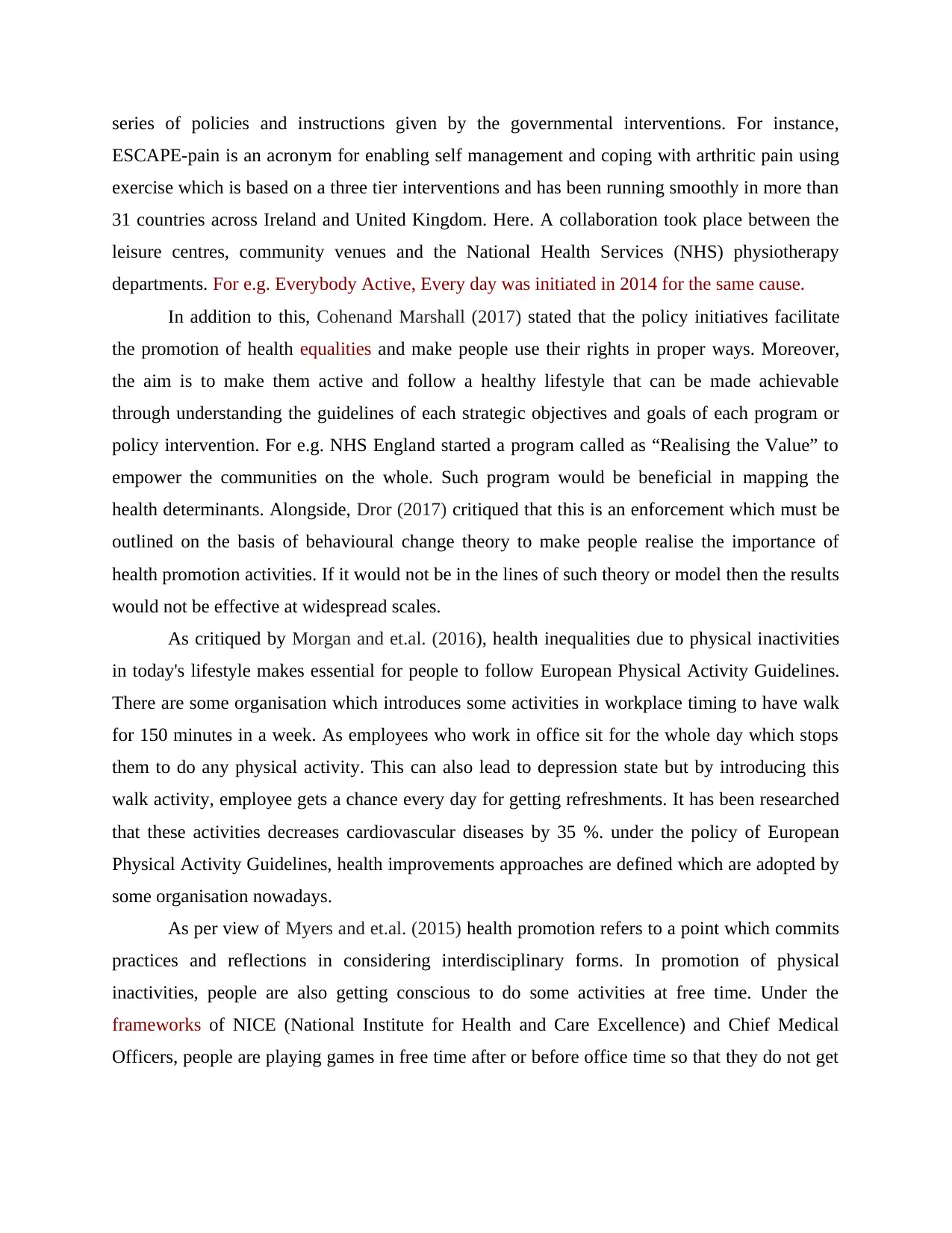
series of policies and instructions given by the governmental interventions. For instance,
ESCAPE-pain is an acronym for enabling self management and coping with arthritic pain using
exercise which is based on a three tier interventions and has been running smoothly in more than
31 countries across Ireland and United Kingdom. Here. A collaboration took place between the
leisure centres, community venues and the National Health Services (NHS) physiotherapy
departments. For e.g. Everybody Active, Every day was initiated in 2014 for the same cause.
In addition to this, Cohenand Marshall (2017) stated that the policy initiatives facilitate
the promotion of health equalities and make people use their rights in proper ways. Moreover,
the aim is to make them active and follow a healthy lifestyle that can be made achievable
through understanding the guidelines of each strategic objectives and goals of each program or
policy intervention. For e.g. NHS England started a program called as “Realising the Value” to
empower the communities on the whole. Such program would be beneficial in mapping the
health determinants. Alongside, Dror (2017) critiqued that this is an enforcement which must be
outlined on the basis of behavioural change theory to make people realise the importance of
health promotion activities. If it would not be in the lines of such theory or model then the results
would not be effective at widespread scales.
As critiqued by Morgan and et.al. (2016), health inequalities due to physical inactivities
in today's lifestyle makes essential for people to follow European Physical Activity Guidelines.
There are some organisation which introduces some activities in workplace timing to have walk
for 150 minutes in a week. As employees who work in office sit for the whole day which stops
them to do any physical activity. This can also lead to depression state but by introducing this
walk activity, employee gets a chance every day for getting refreshments. It has been researched
that these activities decreases cardiovascular diseases by 35 %. under the policy of European
Physical Activity Guidelines, health improvements approaches are defined which are adopted by
some organisation nowadays.
As per view of Myers and et.al. (2015) health promotion refers to a point which commits
practices and reflections in considering interdisciplinary forms. In promotion of physical
inactivities, people are also getting conscious to do some activities at free time. Under the
frameworks of NICE (National Institute for Health and Care Excellence) and Chief Medical
Officers, people are playing games in free time after or before office time so that they do not get
ESCAPE-pain is an acronym for enabling self management and coping with arthritic pain using
exercise which is based on a three tier interventions and has been running smoothly in more than
31 countries across Ireland and United Kingdom. Here. A collaboration took place between the
leisure centres, community venues and the National Health Services (NHS) physiotherapy
departments. For e.g. Everybody Active, Every day was initiated in 2014 for the same cause.
In addition to this, Cohenand Marshall (2017) stated that the policy initiatives facilitate
the promotion of health equalities and make people use their rights in proper ways. Moreover,
the aim is to make them active and follow a healthy lifestyle that can be made achievable
through understanding the guidelines of each strategic objectives and goals of each program or
policy intervention. For e.g. NHS England started a program called as “Realising the Value” to
empower the communities on the whole. Such program would be beneficial in mapping the
health determinants. Alongside, Dror (2017) critiqued that this is an enforcement which must be
outlined on the basis of behavioural change theory to make people realise the importance of
health promotion activities. If it would not be in the lines of such theory or model then the results
would not be effective at widespread scales.
As critiqued by Morgan and et.al. (2016), health inequalities due to physical inactivities
in today's lifestyle makes essential for people to follow European Physical Activity Guidelines.
There are some organisation which introduces some activities in workplace timing to have walk
for 150 minutes in a week. As employees who work in office sit for the whole day which stops
them to do any physical activity. This can also lead to depression state but by introducing this
walk activity, employee gets a chance every day for getting refreshments. It has been researched
that these activities decreases cardiovascular diseases by 35 %. under the policy of European
Physical Activity Guidelines, health improvements approaches are defined which are adopted by
some organisation nowadays.
As per view of Myers and et.al. (2015) health promotion refers to a point which commits
practices and reflections in considering interdisciplinary forms. In promotion of physical
inactivities, people are also getting conscious to do some activities at free time. Under the
frameworks of NICE (National Institute for Health and Care Excellence) and Chief Medical
Officers, people are playing games in free time after or before office time so that they do not get
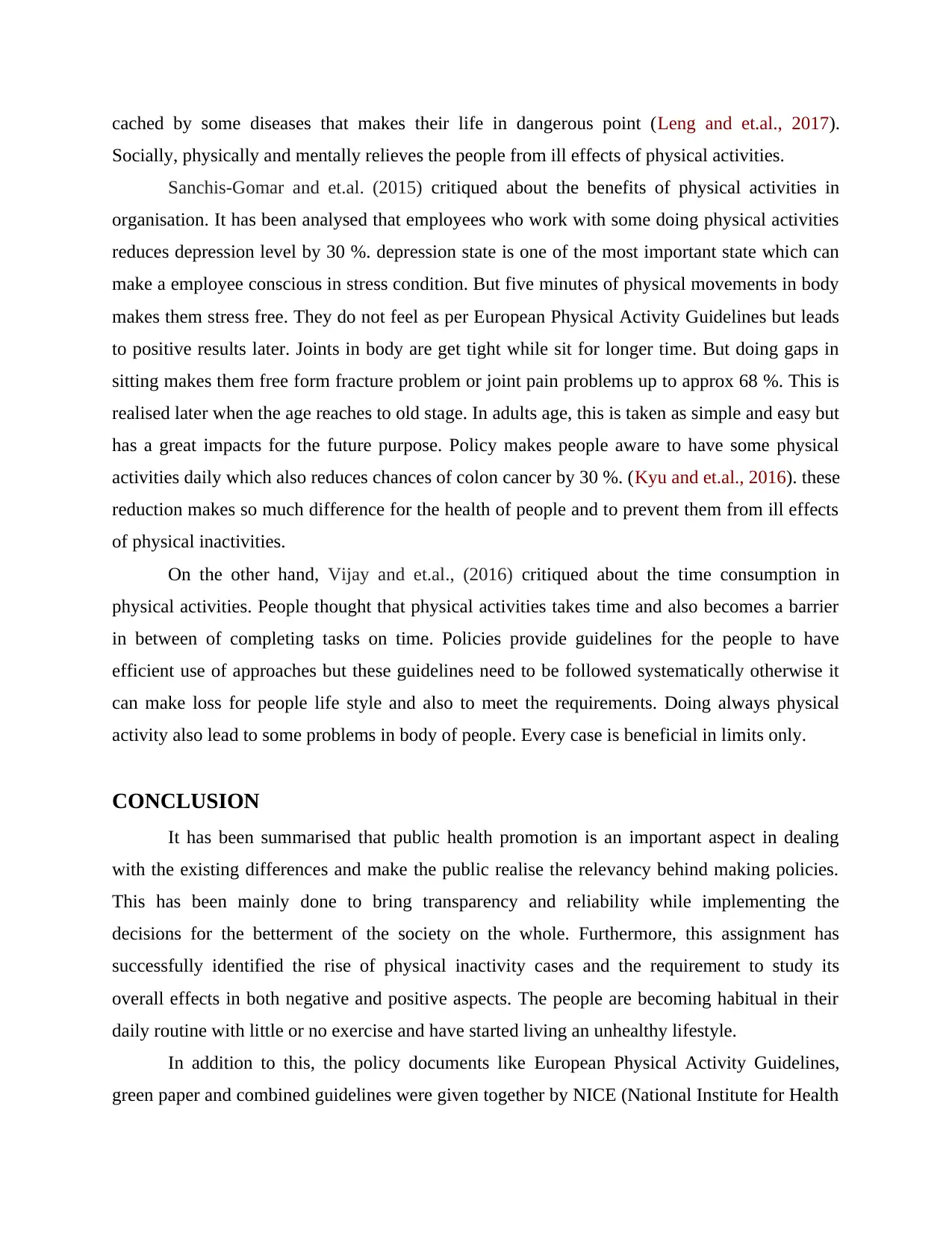
cached by some diseases that makes their life in dangerous point (Leng and et.al., 2017).
Socially, physically and mentally relieves the people from ill effects of physical activities.
Sanchis-Gomar and et.al. (2015) critiqued about the benefits of physical activities in
organisation. It has been analysed that employees who work with some doing physical activities
reduces depression level by 30 %. depression state is one of the most important state which can
make a employee conscious in stress condition. But five minutes of physical movements in body
makes them stress free. They do not feel as per European Physical Activity Guidelines but leads
to positive results later. Joints in body are get tight while sit for longer time. But doing gaps in
sitting makes them free form fracture problem or joint pain problems up to approx 68 %. This is
realised later when the age reaches to old stage. In adults age, this is taken as simple and easy but
has a great impacts for the future purpose. Policy makes people aware to have some physical
activities daily which also reduces chances of colon cancer by 30 %. (Kyu and et.al., 2016). these
reduction makes so much difference for the health of people and to prevent them from ill effects
of physical inactivities.
On the other hand, Vijay and et.al., (2016) critiqued about the time consumption in
physical activities. People thought that physical activities takes time and also becomes a barrier
in between of completing tasks on time. Policies provide guidelines for the people to have
efficient use of approaches but these guidelines need to be followed systematically otherwise it
can make loss for people life style and also to meet the requirements. Doing always physical
activity also lead to some problems in body of people. Every case is beneficial in limits only.
CONCLUSION
It has been summarised that public health promotion is an important aspect in dealing
with the existing differences and make the public realise the relevancy behind making policies.
This has been mainly done to bring transparency and reliability while implementing the
decisions for the betterment of the society on the whole. Furthermore, this assignment has
successfully identified the rise of physical inactivity cases and the requirement to study its
overall effects in both negative and positive aspects. The people are becoming habitual in their
daily routine with little or no exercise and have started living an unhealthy lifestyle.
In addition to this, the policy documents like European Physical Activity Guidelines,
green paper and combined guidelines were given together by NICE (National Institute for Health
Socially, physically and mentally relieves the people from ill effects of physical activities.
Sanchis-Gomar and et.al. (2015) critiqued about the benefits of physical activities in
organisation. It has been analysed that employees who work with some doing physical activities
reduces depression level by 30 %. depression state is one of the most important state which can
make a employee conscious in stress condition. But five minutes of physical movements in body
makes them stress free. They do not feel as per European Physical Activity Guidelines but leads
to positive results later. Joints in body are get tight while sit for longer time. But doing gaps in
sitting makes them free form fracture problem or joint pain problems up to approx 68 %. This is
realised later when the age reaches to old stage. In adults age, this is taken as simple and easy but
has a great impacts for the future purpose. Policy makes people aware to have some physical
activities daily which also reduces chances of colon cancer by 30 %. (Kyu and et.al., 2016). these
reduction makes so much difference for the health of people and to prevent them from ill effects
of physical inactivities.
On the other hand, Vijay and et.al., (2016) critiqued about the time consumption in
physical activities. People thought that physical activities takes time and also becomes a barrier
in between of completing tasks on time. Policies provide guidelines for the people to have
efficient use of approaches but these guidelines need to be followed systematically otherwise it
can make loss for people life style and also to meet the requirements. Doing always physical
activity also lead to some problems in body of people. Every case is beneficial in limits only.
CONCLUSION
It has been summarised that public health promotion is an important aspect in dealing
with the existing differences and make the public realise the relevancy behind making policies.
This has been mainly done to bring transparency and reliability while implementing the
decisions for the betterment of the society on the whole. Furthermore, this assignment has
successfully identified the rise of physical inactivity cases and the requirement to study its
overall effects in both negative and positive aspects. The people are becoming habitual in their
daily routine with little or no exercise and have started living an unhealthy lifestyle.
In addition to this, the policy documents like European Physical Activity Guidelines,
green paper and combined guidelines were given together by NICE (National Institute for Health
⊘ This is a preview!⊘
Do you want full access?
Subscribe today to unlock all pages.

Trusted by 1+ million students worldwide
1 out of 19
Related Documents
Your All-in-One AI-Powered Toolkit for Academic Success.
+13062052269
info@desklib.com
Available 24*7 on WhatsApp / Email
![[object Object]](/_next/static/media/star-bottom.7253800d.svg)
Unlock your academic potential
Copyright © 2020–2025 A2Z Services. All Rights Reserved. Developed and managed by ZUCOL.





